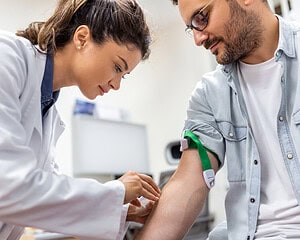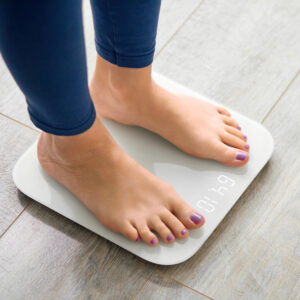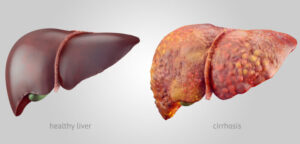
Liver Disease: 7 Things You Need to Know

When liver function drops—the rest of the body feels it. Our liver is the second largest organ in the body, after skin. When it’s running at optimum health—other organs can also run optimally—including the heart, lungs, brain—and yes, digestion.
It’s true that many people ignore the liver—the question is, why?
Gastroenterologist David Cristin, MD with Gastroenterology of the Rockies explains why it’s easy to overlook the liver: “People often ignore liver health because patients with chronic liver disease are usually asymptomatic and only start to develop symptoms when their liver disease has already progressed to late stages.”
He went on to say, patients often don’t think they could be at risk of liver failure–especially when they do not drink alcohol.
“The majority of the general population think that excessive alcohol consumption is one of the only ways someone can develop cirrhosis,” Dr. Cristin said.
1. What are the early signs of liver damage?
Some people won’t feel signs of liver damage, even when their liver is under stress. We refer it as silent symptoms, and it’s not uncommon.
“Patients have to be aware t

hat early liver disease doesn’t give any specific signs. Most of the time early liver disease is only recognized through blood work,” said Raul Cubillas, MD, gastroenterologist with Gastroenterology of the Rockies.
“During your routine follow
up, liver tests are usually checked. Always ask your doctor if your liver tests look normal.”
Blood work helps your doctor confirm if you have some form of liver disease, Dr. Cubillas said.
“Acute or sudden onset vs chronic, which develops over time, these scenarios present two very different types of liver disease. You can always ask your primary care doctor to refer you to a liver specialist.”
Common Symptoms of Liver Damage.
- Fatigue and weakness
- Yellowing of the skin or eyes (jaundice)
- Dark urine or Pale stool – might be linked to bile flow
- Abdominal discomfort
- Notice if you have swelling or pain in the upper right abdomen
If you have symptoms, don’t ignore them, says Dr. Cubillas.
“When you have symptoms like yellow eyes, fluid in your abdomen like abdominal distension make an appointment to your primary care doctor,” he said.
This can help prevent further complications, especially if you have family history of liver disease.
2. Obesity: A Risk for Fatty Liver Disease
 Obesity and Fatty Liver Disease (FLD) are connected. FLD is characterized by an accumulation of fat buildup in the liver.
Obesity and Fatty Liver Disease (FLD) are connected. FLD is characterized by an accumulation of fat buildup in the liver.
There are two types.
- Non-alcoholic Fatty Liver Disease (NAFLD)
- Alcoholic Fatty Liver Disease (AFLD) or Alcoholic Steatohepatitis
Did you know FLD, known as hepatic steatosis, affects about 52% of adults?
New research findings reported in the Journal Obesity indicate the prevalence of FLD in more than half of adults with or without type 2 diabetes—and no known history of metabolic dysfunction-associated steatotic liver disease (MASLD).
Researchers also noted obesity as a risk factor that can double the prevalence of fatty liver disease—and increased fibrosis, which indicates scarring and inflammation in the liver as the disease progresses.
Early intervention and screening can help prevent an individual’s liver disease from progressing to irreversible liver failure also known as cirrhosis. This is especially true for people with diabetes and obesity.
Data suggests a growing number of younger people under age 45 with increased incidence of liver disease–and fibrosis typical with older adults, when co-occurring diabetes and obesity are present.
- Metabolic Dysfunction-associated Steatotic Liver Disease or Metabolic Dysfunction-associated Steatohepatitis
- Obesity
- Obstructive Sleep Apnea and Insulin Resistance
Dr. Cristin pointed out that FibroScan® is one of the best non-invasive tests to assess severity of hepatic fibrosis or scarring. “The severity of hepatic fibrosis is one of the most important predictors of overall liver health,” he said.
Testing the Liver Using Ultrasound
Want a picture of your liver’s health? Ask our GI doctors with advance liver expertise if you’re a candidate for ultrasound-based Fibro scan®. Patients with chronic liver disease could potentially benefit from FibroScan. At Gastroenterology of the Rockies, our doctors and PAs use this non-invasive assessment of fibrosis (scarring).
Patients with the following risk factors may benefit from FibroScan.

3. Improving Liver Health with Diet
Improving liver health starts with the foods we eat. Making the right food choices might be one of your best defenses against liver disease.
For optimal liver health, Nathan Susnow, MD, gastroenterologist with Gastroenterology of the Rockies suggests eating foods found in the Mediterranean diet.
And of course, that means limiting ultra-processed foods. Even though the Mediterranean Diet allows small amounts of red wine, Dr. Susnow reminds us of risks linked to alcohol consumption.
“If you have any history of excess alcohol use or abuse, or have liver disease, then the safest approach is to avoid all alcohol. We know now that there is no healthy amount of alcohol, including red wine,” Dr. Susnow said.
Foods in the Mediterranean Diet
- Leafy greens: Spinach and kale –great source of rich antioxidants.
- Cruciferous vegetables: Broccoli and Brussels sprouts – these high-fiber favorites help flush toxins.
- Healthy fats: Avocados and olive oil – may help decrease liver fat accumulation, and oxidative stress, compared to other oils.
- Avocados are high in fiber and monounsaturated fat
- While more research is needed, phenols in avocados are linked to lowering non-alcoholic liver disease.(NAFLD) [Source: Frontiers in Pharmacology]
- Fish and Chicken-Salmon provides omega-3 fatty acids.
- Eggs-High protein source and healthy fats.
- Fruits and berries- Good sources of antioxidants and fiber.
- Whole grains and sweet potatoes – Provides fiber and complex carbohydrates.
Always talk to your doctor before changing your diet.
In general, try to avoid excessive sugar, fried foods and alcohol. Consumed in excess, these foods are linked to fatty liver disease or inflammation.
Did You Know? Drinking coffee and tea in moderation is linked to lower risks of liver diseases such as cirrhosis, according to research.
4. Better Habits, Better Liver Health through Daily Movement
Better habits boil down to better choices. Are you getting enough daily movement? Keep in mind, daily movement comes in many forms. Find something you like and it just might turn into an enjoyable habit that

keeps you healthy while reducing stress.
“Habits like regular exercise show increasing evidence for benefit in patients with all stages of liver disease,” Dr. Susnow said. “In the past we focused on cardio such as walking or biking, but there is increasing evidence that advanced liver disease leads to muscle wasting and this can be combated by incorporating strength training.”
He said lifting weights two or three times per week can have a beneficial effect on your health, even in small amounts
Try to get a mix of cardio exercise, strength training and balance or mobility work, says Dr. Susnow. Any amount of exercise every day can make a difference, he added.
- Take the stairs instead of the elevator
- Give yourself 10-15 minutes for yoga, stretching or squats
Combining daily movement with a healthy diet are two essential habits for anyone who wants to drop a few pounds. And besides being able to zip up your jeans a little easier, weight loss can also give your liver a boost.
“If you are overweight, losing even a small amount of weight can reduce the amount of inflammation in the liver for many patients,” Dr. Susnow said.
5. How to Reverse Liver Damage-Can it be done?

People often ask how to reverse liver damage.
The liver is a workhorse. It aids in digestion, metabolism, detoxification, blood filtering, to name a few functions.
And it’s known for its healing abilities, however, reversing liver damage depends on a few factors. But fi
rst, your doctor will want to assess the full extent of liver damage.
- Fatty liver disease: Often reversible with dietary changes, weight loss and exercise.
- Alcoholic liver damage early stage: Sometimes reversible when people quit drinking alcohol.
- Cirrhosis: Early intervention is key to help prevent more damage, however, scarring is permanent.
A Word About Cirrhosis: “Long term exposure to excessive alcohol consumption is well-known to cause progression of fatty liver to irreversible liver failure, also known as cirrhosis. Unfortunately, the only cure for cirrhosis is a liver transplant,” Dr. Cristin said.
Remember: Early intervention helps you address potential liver issues—and that means you may improve or reverse some liver damage. Consult with your doctor or PA for a treatment plan that addresses liver health and ways to help reverse liver damage. Remember, regular check-ups can help you stay on track.
6. How Does Alcohol Affect the Liver?
 Alcohol is ubiquitous. And historically, alcohol has been one of the most socially accepted behaviors—whether it’s part of a family get together or sporting event. However, alcohol consumption and its effect on liver health depends on several factors. Frequency and amount of alcohol consumption, plus drinking patterns determine how alcohol affects the liver.
Alcohol is ubiquitous. And historically, alcohol has been one of the most socially accepted behaviors—whether it’s part of a family get together or sporting event. However, alcohol consumption and its effect on liver health depends on several factors. Frequency and amount of alcohol consumption, plus drinking patterns determine how alcohol affects the liver.
Even moderate drinking can harm your liver, especially with frequent consumption. Here’s what can happen with chronic alcohol consumption.
- Fatty liver disease: Fat buildup in liver cells.
- Hepatitis: Inflammation and possible scarring.
- Cirrhosis: Severe liver damage, often irreversible.
Alcohol is just one of the many causes of liver disease, says Dr. Cubillas.
“Regardless of the reason for advanced liver disease, the use of alcohol could aggravate it. By becoming abstinent from alcohol there is one less reason for liver damage.”
Dr. Cubillas points out that several studies suggest that patients who become abstinent show less progression of liver disease.
Surprising Fact: Women are more prone to alcohol-induced liver damage than men. That’s because women and men metabolize alcohol differently. [Source: Frontiers in Gastroenterology, 2022]
Current recommended guidelines—less alcohol is better
– One drink per day or less, for women
– Two drinks per day or less, for men
– Include alcohol-free days to let the liver rest
7. What we think about liver detox products
Liver detox products often claim to cleanse the liver. But your body already has a built-in detoxification system. Instead of expensive detox products, focus on these habits instead, says Dr. Susnow. 
- Stay hydrated: Water helps the liver process toxins.
- Eat a balanced diet: Nutrient-dense foods support liver function.
- Limit harmful substances: Minimize alcohol, processed foods, and unnecessary medications.
Reality Check: Many detox products lack scientific proof. Support your liver with healthy choices.
“The best liver detox is a healthy diet with plenty of fruits, vegetables, and high fiber grains, limiting your intake of ultra-processed foods, and avoiding alcohol. The liver detox kits you can buy are at best a waste of your money,” Dr. Susnow said.
Your liver works hard every day to keep your body running smoothly, but it’s up to you to take care of it. If you have a family history of liver disease, are experiencing symptoms, or have concerns about your liver health, don’t wait—schedule a visit with your doctor.
Prevention and early detection can help your liver stay healthy.
Want to learn more about maintaining a healthy liver? Share this article and spread the knowledge. Or call 303-604-5000 to book a consultation with our GI specialists with expertise in complex liver disease.
Produced by Elise Oberliesen, digital marketing specialist; medical review provided by David Cristin, MD, January, 2025.
